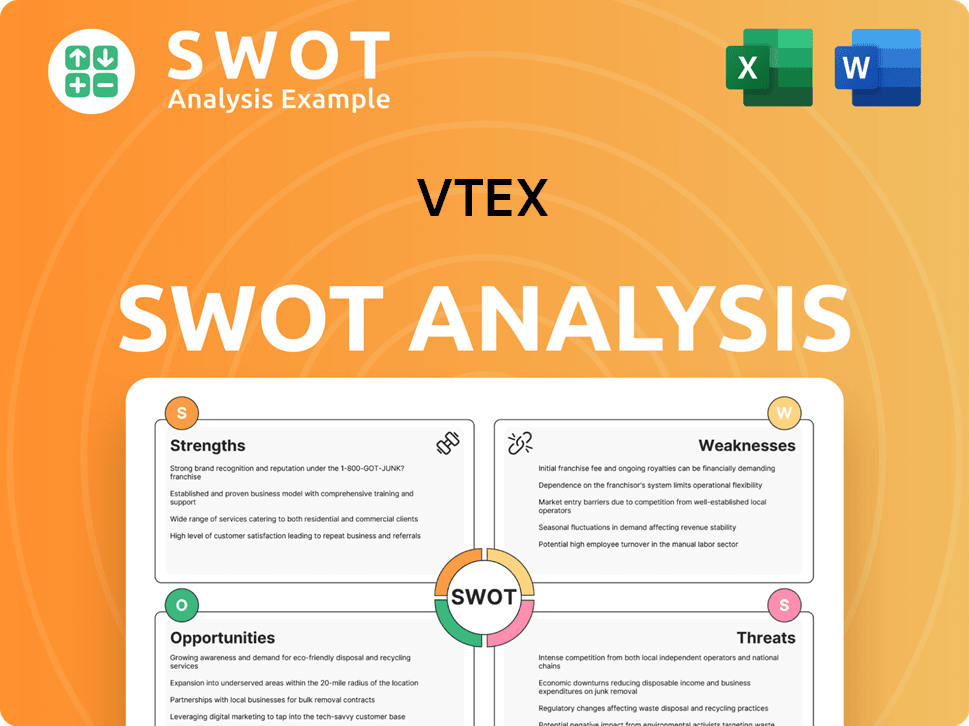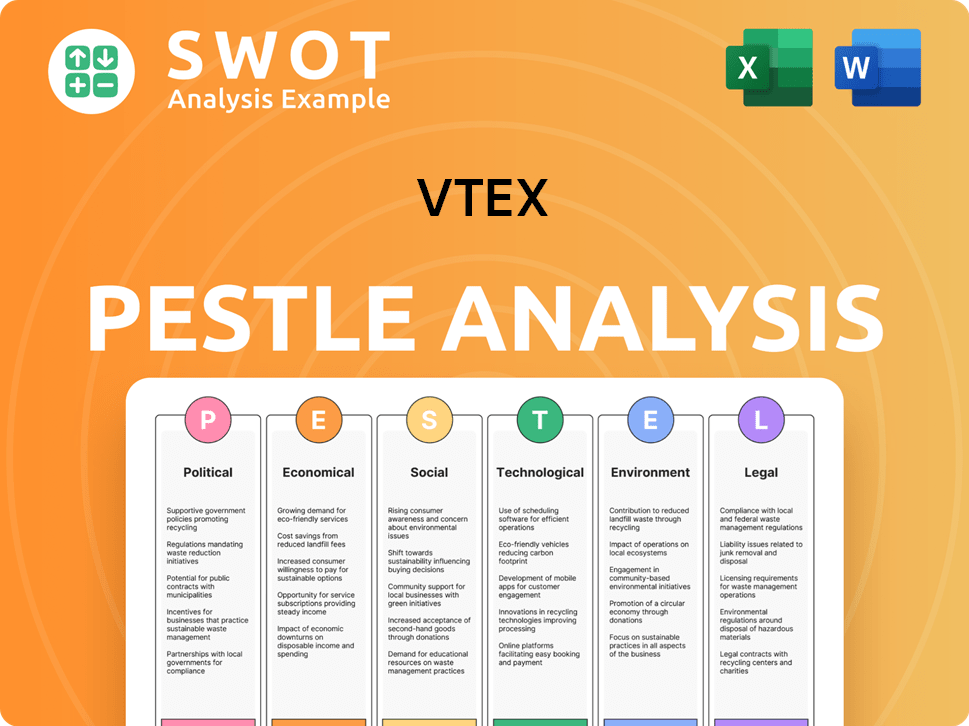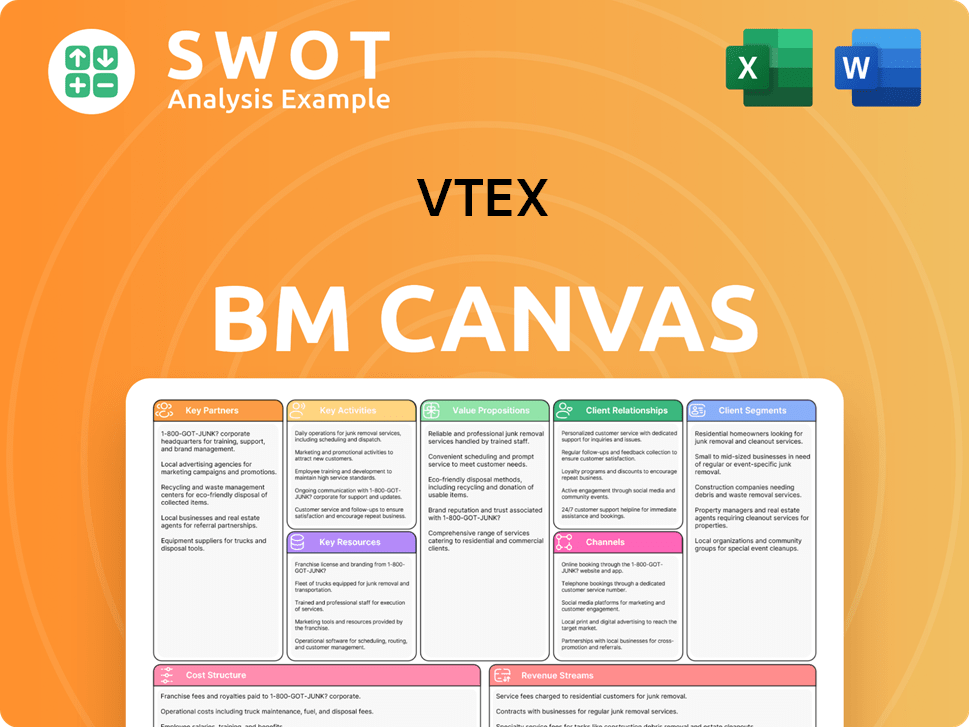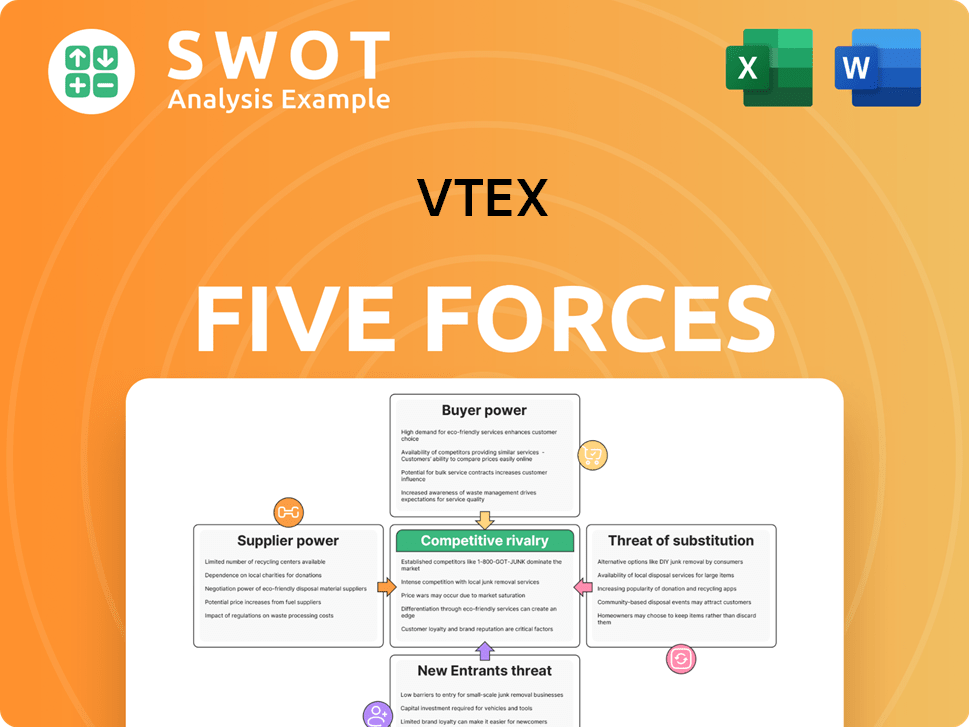VTEX Bundle
Can VTEX Conquer the Ever-Changing E-commerce Arena?
The digital commerce world is a battlefield, and understanding the VTEX SWOT Analysis of key players is crucial. VTEX, a significant force in the SaaS digital commerce platform market, is constantly evolving. This analysis dives into the competitive landscape, offering a detailed look at its position in the market.

This exploration provides a comprehensive VTEX market analysis, examining its competitors, strengths, and weaknesses to help you understand its potential. We'll dissect the VTEX competitive landscape, comparing its features and capabilities against other e-commerce platforms. From VTEX vs Shopify comparison to VTEX competitor pricing, we'll provide actionable insights for informed decision-making, including the VTEX future outlook and growth.
Where Does VTEX’ Stand in the Current Market?
As of early 2025, the digital commerce industry sees VTEX holding a strong market position, especially in Latin America. The company offers a SaaS digital commerce platform, enabling businesses to build online stores, manage orders, and provide customer service. VTEX serves a diverse customer base, including enterprise brands and retailers, with solutions for B2C, B2B, and marketplace commerce.
The company's market share in Latin America is estimated at 32%. Globally, VTEX's estimated market share in the e-commerce platform sector for 2024/2025 is approximately 2-4%. This indicates a significant presence in a competitive market. VTEX continues to expand its global footprint, with a focus on North America and Europe, aiming to capture a larger market share.
VTEX's platform is designed to support various commerce models, which is a key aspect of its value proposition. VTEX provides a comprehensive suite of tools and services to meet the evolving needs of businesses in the digital commerce space. The company's ability to serve both B2C and B2B clients, along with marketplace capabilities, positions it well to capitalize on diverse market opportunities.
In Latin America, VTEX dominates with a 32% market share. Globally, it holds approximately 2-4% of the e-commerce platform market. This strong regional presence and growing global footprint are crucial for its competitive standing. VTEX's focus on enterprise brands and retailers further solidifies its position.
In Q1 2025, VTEX's Gross Merchandise Volume (GMV) reached US$4.3 billion, a 17.2% year-over-year increase on an FX neutral basis. Total revenue for Q1 2025 increased to US$54.2 million, up 13.2% year-over-year. Subscription revenue accounted for 97.1% of total revenues at US$52.6 million, showing strong recurring revenue.
The number of enterprise customers generating over $250,000 in revenue for VTEX grew by 23% in 2024. This indicates strong customer retention and expansion. VTEX's ability to attract and retain enterprise clients is a key competitive advantage. The company's focus on enterprise solutions drives revenue growth.
VTEX is transitioning to U.S. GAAP accounting standards by 2025, which aims to enhance global credibility. The company's strategic shifts, including its global expansion, aim to capture a larger market share. VTEX's focus on international markets is evident in its expansion efforts.
VTEX's strong presence in Latin America, coupled with its global expansion, positions it as a significant player in the e-commerce platform market. The company's focus on enterprise clients and its SaaS model contribute to its financial success. The company's financial health is reinforced by consistent revenue growth and improved margins.
- Strong market share in Latin America.
- Growing global presence, particularly in the US and Europe.
- Consistent revenue growth and improved margins.
- Focus on enterprise clients and SaaS model.
For further insights, you can explore the Growth Strategy of VTEX to understand the company's strategic initiatives in greater detail. VTEX's success is fueled by its robust platform features and its ability to adapt to evolving industry trends.
VTEX SWOT Analysis
- Complete SWOT Breakdown
- Fully Customizable
- Editable in Excel & Word
- Professional Formatting
- Investor-Ready Format

Who Are the Main Competitors Challenging VTEX?
The VTEX competitive landscape is dynamic, shaped by a mix of established players and emerging specialists. This analysis of VTEX competitors explores the key rivals in the e-commerce platform comparison, considering their strengths and how they challenge VTEX’s market position. Understanding these competitive dynamics is crucial for businesses evaluating e-commerce solutions and for investors assessing VTEX's future outlook and growth.
The e-commerce market is highly competitive, with significant players vying for market share. This competition is driven by the increasing demand for online retail solutions and the continuous evolution of technology. VTEX, as a major player, faces challenges and opportunities in this environment, requiring it to continually innovate and adapt to stay ahead.
VTEX competes with various platforms catering to different business needs and scales. Key competitors include Shopify Plus, SAP Commerce Cloud, Adobe Commerce (formerly Magento), BigCommerce, Commercetools, Spryker, and HCL Commerce Cloud. Each platform offers unique features and caters to specific market segments, influencing the VTEX market analysis.
Shopify, with an estimated global e-commerce platform market share of 20-25% in 2024/2025, is a major competitor. Its ease of use and extensive app ecosystem make it a strong contender, particularly for SMBs. Shopify Plus specifically targets brands seeking rapid e-commerce scaling.
SAP Commerce Cloud is a significant enterprise-focused competitor. It is known for its strong CRM integration and AI capabilities. This platform often appeals to businesses looking for comprehensive solutions with robust backend support.
Adobe Commerce (Magento) is highly customizable and strong in B2B features. It is favored by businesses requiring more tailored solutions. Its flexibility allows for complex implementations and integrations.
BigCommerce is known for its native B2C and B2B functionality, composable architecture, and omnichannel capabilities. It offers a robust platform for businesses of various sizes. A detailed VTEX vs BigCommerce comparison reveals key differences.
Commercetools and Spryker are emerging players that offer composable commerce solutions. These platforms provide flexibility and adaptability, particularly for large enterprises. They focus on API-first approaches and modular architectures.
HCL Commerce Cloud is another competitor, offering comprehensive e-commerce solutions. It caters to businesses with complex requirements and focuses on scalability and performance.
Competitors challenge VTEX through various means, including offering greater flexibility, adaptability, and innovation. The increasing adoption of composable commerce strategies and API-first approaches by various platforms indicates a shift towards more flexible and customizable solutions. Many of VTEX's larger competitors possess substantial competitive advantages.
- Ease of Use: Shopify's user-friendly interface and extensive app ecosystem make it a strong choice for SMBs.
- Customization: Adobe Commerce (Magento) offers high levels of customization, appealing to businesses with specific needs.
- Integration: SAP Commerce Cloud excels in CRM integration, providing a unified customer experience.
- Composable Commerce: Platforms like Commercetools and Spryker offer flexible, API-first solutions.
- Market Share: Shopify's significant market share (20-25%) gives it a strong competitive edge.
VTEX PESTLE Analysis
- Covers All 6 PESTLE Categories
- No Research Needed – Save Hours of Work
- Built by Experts, Trusted by Consultants
- Instant Download, Ready to Use
- 100% Editable, Fully Customizable

What Gives VTEX a Competitive Edge Over Its Rivals?
Analyzing the VTEX competitive landscape reveals a company with distinct advantages in the digital commerce sector. VTEX competitors are numerous, but VTEX differentiates itself through its unique platform and strategic focus. This VTEX market analysis highlights key strengths that contribute to its competitive edge.
VTEX has strategically positioned itself in the e-commerce market by offering a composable and complete commerce platform. This approach allows businesses to customize their e-commerce solutions without sacrificing core functionalities, catering to complex enterprise needs. A key aspect of its strategy involves continuous innovation, particularly in AI-driven features, to optimize digital commerce functions.
VTEX has a strong presence in Latin America, providing a solid foundation for global expansion. This regional expertise allows it to deliver solutions that accommodate differences across regions, tax jurisdictions, and local consumer preferences. The company continues to invest in Research & Development (R&D) to fuel platform innovation and maintain its competitive advantage in the rapidly evolving e-commerce industry.
VTEX offers a composable and complete commerce platform, combining comprehensive features with the flexibility of a composable architecture. This enables businesses to tailor their e-commerce solutions without compromising core functionalities. This pragmatic composability approach empowers brands, distributors, and retailers with unparalleled flexibility.
VTEX holds a strong position in Latin America, leveraging its deep roots and extensive experience in the region. This regional expertise allows VTEX to provide solutions that accommodate regional differences, tax jurisdictions, and local consumer preferences. Many large enterprises in Latin America rely on its solutions.
Unlike many competitors, VTEX provides built-in capabilities for businesses to expand their product offerings through third-party sellers. The platform's rich API for native functionality further enhances its appeal, offering deep integration and extensive capabilities within the VTEX ecosystem. This includes features like catalog management, pricing, promotions, and order handling.
VTEX invests heavily in Research & Development (R&D) to drive platform innovation, delivering frequent updates and new features, including AI capabilities. VTEX leverages AI to optimize various digital commerce functions, such as personalized recommendations and dynamic pricing strategies. The company offers AI-driven tools like the AI-Driven Ad Network and AI-Powered Intelligent Search.
VTEX's competitive advantages are built on a composable architecture, strong regional presence, and continuous innovation. These factors contribute to the sustainability of its market position, although the company faces challenges from imitation and the need for ongoing adaptation. The company's commitment to evolving from enablement to execution, simplifying commerce for complex organizations, is a key differentiator.
- Composable Architecture: Provides unparalleled flexibility for customization.
- Market Leadership in Latin America: Offers deep regional expertise and a strong base for global expansion.
- Native Marketplace Functionality: Simplifies the expansion of product offerings.
- Continuous Innovation: Drives platform updates and AI-driven features.
For a deeper dive into how VTEX is executing its growth strategy, consider reading about the Growth Strategy of VTEX.
VTEX Business Model Canvas
- Complete 9-Block Business Model Canvas
- Effortlessly Communicate Your Business Strategy
- Investor-Ready BMC Format
- 100% Editable and Customizable
- Clear and Structured Layout

What Industry Trends Are Reshaping VTEX’s Competitive Landscape?
The digital commerce industry is experiencing significant shifts, creating both opportunities and challenges for companies like VTEX. The competitive landscape is dynamic, with established players and emerging technologies constantly reshaping the market. Understanding the current trends and future outlook is crucial for navigating this evolving environment and making informed strategic decisions. For a deeper understanding of the company's background, you can explore the Brief History of VTEX.
VTEX's competitive position is influenced by industry trends, technological advancements, and regulatory changes. It faces competition from both established e-commerce platforms and emerging technologies. Analyzing these factors is essential for understanding VTEX's market dynamics and potential for growth.
Artificial intelligence (AI) is transforming e-commerce, with applications in personalization and process optimization. Online marketplaces continue to grow, and B2B companies are increasingly seeking e-commerce platforms with marketplace functionalities. Regulatory changes concerning privacy and data usage are tightening globally, impacting how platforms operate.
Intense global competition from well-funded players poses a significant challenge. Macroeconomic slowdowns can affect client spending and Gross Merchandise Volume (GMV). Currency fluctuations, particularly in Latin America, present financial risks. Rapid technological advancements require continuous innovation and adaptation.
The global e-commerce market is projected to grow substantially, with digital commerce sales expected to account for 25% of total retail sales by 2027. Expansion in North America and Europe offers significant growth potential. The B2B sector represents a key area for growth, including the creation of new business lines through B2B marketplaces.
VTEX is focusing on global expansion, particularly in North America and Europe. They are targeting larger enterprise clients and expanding into the B2B sector. Product innovations, like an integrated suite of solutions, and strategic partnerships are key. They aim for long-term value creation through sustainable growth strategies.
VTEX's growth strategy includes geographical expansion and a focus on enterprise clients. The B2B sector and product innovation are also major areas of focus, as the company aims to capture a larger market share. Strategic partnerships and ecosystem integrations are crucial for expanding reach and capabilities.
- Global Expansion: Expanding into North America and Europe to tap into new markets.
- Enterprise Focus: Targeting larger enterprise clients to increase revenue and market share.
- B2B Sector: Leveraging the growing B2B e-commerce market through marketplace functionalities.
- Product Innovation: Developing an integrated suite of solutions to enhance capabilities.
VTEX Porter's Five Forces Analysis
- Covers All 5 Competitive Forces in Detail
- Structured for Consultants, Students, and Founders
- 100% Editable in Microsoft Word & Excel
- Instant Digital Download – Use Immediately
- Compatible with Mac & PC – Fully Unlocked

Related Blogs
- What are Mission Vision & Core Values of VTEX Company?
- What is Growth Strategy and Future Prospects of VTEX Company?
- How Does VTEX Company Work?
- What is Sales and Marketing Strategy of VTEX Company?
- What is Brief History of VTEX Company?
- Who Owns VTEX Company?
- What is Customer Demographics and Target Market of VTEX Company?
Disclaimer
All information, articles, and product details provided on this website are for general informational and educational purposes only. We do not claim any ownership over, nor do we intend to infringe upon, any trademarks, copyrights, logos, brand names, or other intellectual property mentioned or depicted on this site. Such intellectual property remains the property of its respective owners, and any references here are made solely for identification or informational purposes, without implying any affiliation, endorsement, or partnership.
We make no representations or warranties, express or implied, regarding the accuracy, completeness, or suitability of any content or products presented. Nothing on this website should be construed as legal, tax, investment, financial, medical, or other professional advice. In addition, no part of this site—including articles or product references—constitutes a solicitation, recommendation, endorsement, advertisement, or offer to buy or sell any securities, franchises, or other financial instruments, particularly in jurisdictions where such activity would be unlawful.
All content is of a general nature and may not address the specific circumstances of any individual or entity. It is not a substitute for professional advice or services. Any actions you take based on the information provided here are strictly at your own risk. You accept full responsibility for any decisions or outcomes arising from your use of this website and agree to release us from any liability in connection with your use of, or reliance upon, the content or products found herein.